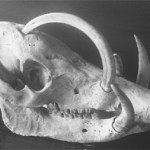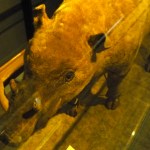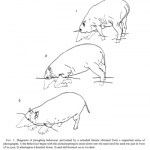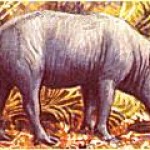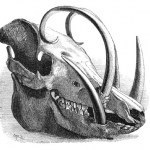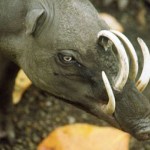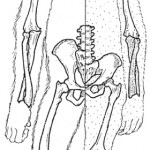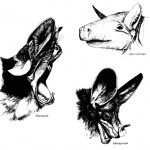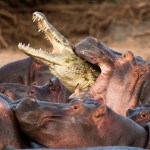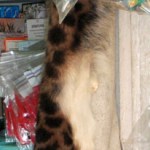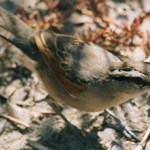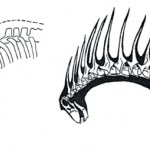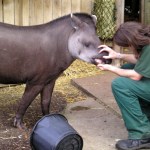mammalogy
Yeah, things are still tough here at Tet Zoo Towers, and the time needed for blog-writing has yet to materialise. But the end is in sight, and things will be back to normal within the next few weeks. I hope.
If you've been reading the series of babirusa articles - and, hey, who hasn't? - you'll recall the mention of that most sought-after of objects: a male babirusa skull where one of the upper canines has pierced the frontal bone, and grown into the skull... perhaps with fatal consequences. Given the extraordinary form of the canines, it seems obvious and perhaps inevitable that at least…
In the previous article we looked at the proposal that the various babirusa taxa - long regarded as subspecies - deserve to be raised to species rank. The argument goes that the taxa concerned are (1) morphologically diagnosable, (2) 'as distinct' as are other taxa traditionally regarded as species (raising the taxa to species level therefore represents a sort of attempt at uniformitarianism), and (3) represent distinct phylogenetic lineages. Meijaard & Groves's proposal therefore reflects their adherance to the phylogenetic species concept, or PSC (where distinct lineages on a…
Welcome to yet another article in the (outstandingly successful, yet recycled from ver 1) series on babirusas. Observant readers will have noticed that, strangely, I've refrained thus far from using a scientific binomial for babirusas, plus I've consistently (I think) referred to them in the plural, and not as a single species. What gives?
Well, the proverbial cat is already out of the bag, but the traditional taxonomy where all babirusas are referred to the single species Babyrousa babyrussa is now defunct and there are good reasons for recognising several species. Babirusa taxonomy was…
The bipedal 'boxing' behaviour of babirusas is odd, but arguably odder is a unique sort of 'ploughing' behaviour they've recently been shown to practise. On being presented with an area of soft sand, captive babirusas (mostly males) have been noted to kneel down and push their head and chest forward through the sand, the result being a deep furrow. One obscure report from the 1970s suggests that Sulawesi people associated babirusas with the creation of straight-line furrows. Possible babirusa furrows were reported from south-eastern Sulawesi in 2002, but this behaviour has otherwise gone…
In the previous articles we looked at the distribution and phylogenetic position of babirusas, and also at a bit of their behaviour, biology and morphology. While babirusas are famous for the bizarre upper canines that emerge from the dorsal surface of the snout in males, the function of these teeth remains uncertain. As we saw in the previous article, it's been proposed that they function in display, in fighting, or in helping the animal to push its way through dense vegetation. The latter idea is least likely and is unsupported by observations. The fighting idea might seem logical and…
Another article on babirusas - yaay! Like many (but not all) pigs, babirusas are omnivorous, and are said to eat invertebrates whenever they find them. They have also been reported to eat fish on occasion, to catch small mammals, and even to catch and eat the juveniles of other babirusas (Leus & Morgan 1995). They eat all kinds of plant material, including fruits, leaves, flowers, berries, nuts, bark and tubers, and they not only browse and dig to obtain such items, they are also surprisingly good at standing bipedally (without support) to feed on leaves. This again is a curious parallel…
More on babirusas! Go here for part I.
While babirusas look pig-like and are classified as part of Suidae, they're distinctive and unusual [image above from wikipedia]. Combining rather slender legs with a barrel-shaped body, they can exceed 1 m in length and have a shoulder height of 65-80 cm. Some individuals weigh as much as 100 kg. Babirusas are odd in having particularly remarkable canines (more about those soon), but less well known is that they differ from other pigs in several details of their anatomy, and in fact resemble peccaries and other artiodactyls in a few features. The…
In the interests of recycling old material from Tet Zoo ver 1, I present... yes, a whole series of articles devoted to one of the most unusual and remarkable of hoofed mammals. Come on, we all love babirusas. If you've been with Tet Zoo from the beginning, none of what's to follow will be new [adjacent photo from here]. For the rest of you: buckle up and enjoy the ride...
You might be surprised to learn that babirusas have been known to westerners for a comparatively long time, having been named Sus babyrussa by Linnaeus in 1758 (the generic name Babyrousa was first coined by Perry in 1811…
I have to take a break. I may be gone for some time... I may not. Here are some cool photos.
Like many people interested in cryptozoology (the study of animals - or alleged animals - known only from anectodal evidence), I'm of the opinion that the Australian Yowie is one of the most problematic of mystery beasts. It is, in fact, so ridiculous and inconvenient that it's difficult to take seriously. As if sasquatch, yeti and orang pendek aren't difficult enough*, what are we to make of antipodean reports of a hairy, bipedal, ape-like creature? Back in 2006 (oh my god, four years ago already), Tony Healy and Paul Cropper collated everything known about the Yowie for their book The…
We've had reason now and again to mention the unusual ape photographed at Yaounde Zoo (in Cameroon) a few times. I finally got round to digging out and scanning the only photo of the animal I've seen: it was taken by Peter Jenkins and Liza Gadsby and first appeared in the November 1996 issue of the Newsletter of the Internal Primate Protection League (IPPL). It was later published in issue 100 of Fortean Times.
Jenkins and Gadsby thought that the animal might be a gorilla-chimp hybrid. I can't help but get this impression too, mostly because the eyes look gorilla-like while the rest of the…
Over the past couple of months I've been reading John MacKinnon's In Search of the Red Ape (Collins, 1974) - one of the first books anyone reads whenever they want to learn about orangutans. The book is stuffed full of anecdotes and other natural history tales about Borneo and Sumatra, and it seems that MacKinnon (who, these days, is best known for his association with the discovery of the Saola Pseudoryx nghetinensis in Vietnam (MacKinnon 2000, Van Dung et al. 1993, 1994)) encountered just about every creature you could hope to encounter in the tropical jungles of the region... yes, even…
I had to scan some hominid pictures today; came across this old classic and thought it worth using here.
Produced by Adrienne Zihlman, the picture has been used to support Zihlman's 'pygmy chimpanzee hypothesis' (Zihlman et al. 1978): this being the idea that the Bonobo Pan paniscus is 'the best prototype for the common ancestor of humans and [other] African apes' (Zihlman 1984, p. 39). Many recent discoveries have shown that at least some australopithecines really were more chimp-like than used to be thought, and the old idea that fossil hominins were just prototype versions of Homo is now…
Time only for a picture-of-the-day post... here are portraits of the big animalivorous microbats Otomops (a molossid, of course*), Cheiromeles (also a molossid) and Vampyrum (a phyllostomid). The pic is from Freeman (1984), but you might notice that two of the drawings are based on the photos featured in Walker's Mammals of the World.
* I say 'of course' as the 'mops' part of the name is strongly associated with this group of bats (popularly known as mastiff bats or free-tailed bats). Besides Mops itself (the greater mastiff bats), there's Platymops, Neoplatymops, Cabreramops, Otomops,…
You've probably seen - presumably on TV - Nile crocs Crocodylus niloticus interacting with Common hippos Hippopotamus amphibius (if you've seen it in real life, lucky you). By and large the two seem to keep apart. Having said that, there are certainly photos of the two sharing the same sandbanks. And then there are those instances of hippos scaring crocs away from carcasses, the weird reports of hippos mouthing and chewing the backs and tails of resting crocodiles, and those cases where crocodiles have been seen to walk or run across hippos' backs.
What can certainly be said to be the most…
By now you might have read my two previous articles (part I, part II) on the assorted tetrapods I encountered in Libya last month. Here's the third and final part in the series [image below shows chital at left, melanistic fallow top-centre, nilgai bottom-centre, blackbuck at right].
It's a bit unusual for a Tet Zoo article, as it contains a whole paragraph of boring travel-writing stuff, but I hope you can grit your teeth and get through this - the meat and potatoes on obscure subspecies and so on is delivered towards the end, I promise. So, without further ado...
Having spent our time in…
My wife gives money to a cancer charity. She gets literature of some sort for doing this, and here's the front cover of the Christmas booklet she recently received. Why, as a Tet Zoo nerd, do I find it so funny?
So, I recently returned from a brief sojourn in Libya. The trip was led by Richard Moody, best known for his work on Cretaceous sea turtles; I was also accompanied by palaeornithologist Gareth Dyke and by a group of people interested in the country's geology.
Libya - officially, the Great Socialist People's Libyan Arab Jamahiriya - is huge: it covers nearly 2 million square kilometres and is the fourth largest African county. However, 90% of the country is desert, and the population is only about 5.7 million (of which nearly 2 million live in Tripoli, the capital). It's a land of…
For the full story on all of this, you'll have to nip over to SV-POW! I guarantee you won't regret it. My favourite 'fact' about potto neck spines: they demonstrate a link with the Chupacabras (no, I don't accept this, but some do take it seriously, apparently).
Observant readers will have noticed problems with Tet Zoo's format over the last few days. This now seems to be sorted, but an unfortunate result is that what's known as my Free Module is now gone. This is the region of the sidebar that had the book adverts and links, web counter, awards, endorsements, paypal icon etc. Bummer. Trying…
After all that talk of tapirs biting people's arms off and killing Brazilian farmers, it only seems appropriate to post these pictures, taken at Bristol Zoo on Sunday (a group of us went there after SVP). The keeper obviously has a great relationship with Denzil, the male Brazilian (or Lowland) tapir Tapirus terrestris on the right (the female, on the left, is called Tamang)...
As for Meller's duck Anas melleri - a species you'll now be very familiar with - I find that they do not hesitate to attack humans, should the opportunity arise...
Still working hard to catch up after SVP, still…
